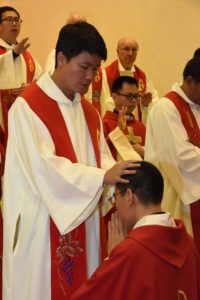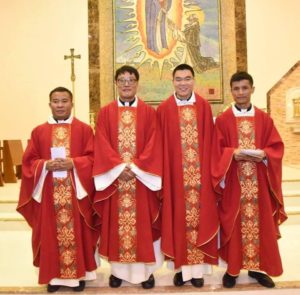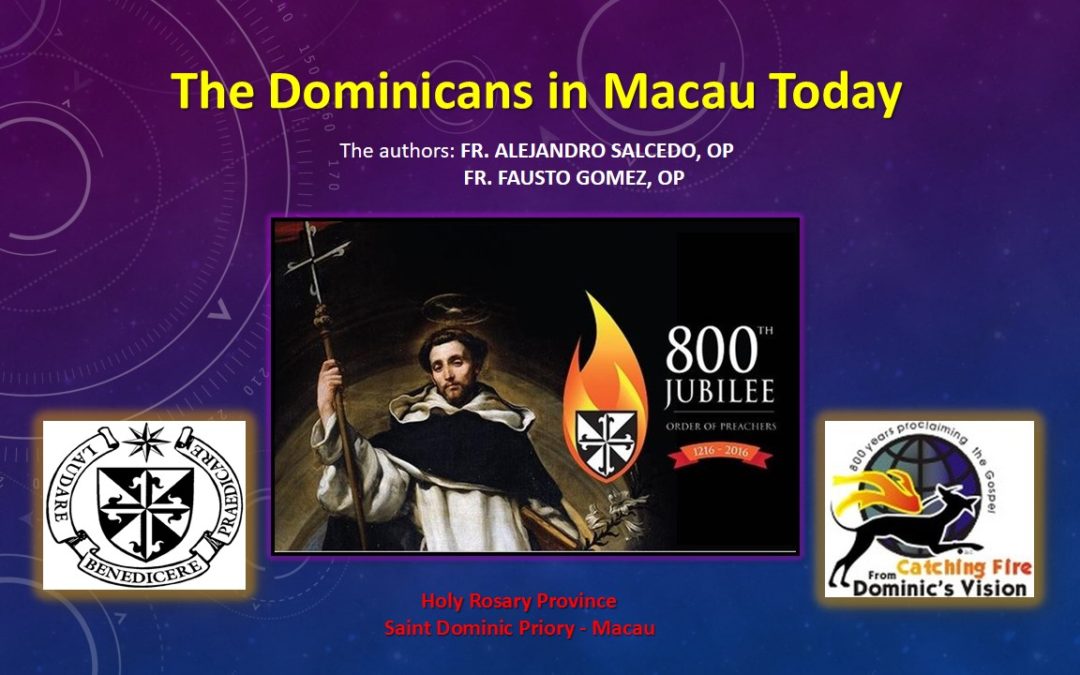
The authors wish to present briefly the reality of life and mission of the Dominican brothers of the Province of Our Lady of the Rosary in Macau.
In the following pages, they try to answer these questions: Who are we? What do we do in Macau? Where do we came from? Where are we going?
1. THE PRESENT: DOMINICANS IN MACAU TODAY
The presence of the Dominican Friars in Macau dates back to 1587, the year of the foundation of the Dominican Province of Our Lady of the Rosary. Through history, according to historical documents, several further attempts were made from the Philippines to establish a permanent presence in Macau. However these attempts, for many different reasons, were never accomplished, as we shall see later.
    Renewed Presence
A new presence of the Province of Our Lady of the Rosary started in Hong Kong in 1935 with the establishment, within St. Albert’s Convent, of the Novitiate for candidates to the Dominican Order from the Philippines, China and other Asian countries. From 1959 on, the Dominican presence and apostolate in Hong Kong was greatly enlarged and enriched with the foundation of Rosaryhill School. To give a new apostolic and educational purpose to the property of the Convent of Saint Albert the Great and to answer the educational needs of the growing population of Hong Kong, the Dominican authorities decided to build and run a school. Rosaryhill School was initially formed by an international community which assisted in the educational and spiritual growth programs of the school. By that time, some brothers began to dream of going back to Macau. As the venerable Fr. Jose Rios, OP, used to say and repeat: “Saint Dominic Church, with its white statue of the Virgin and Child, all the wood statutes of Dominican saints and of the badge of the Order, is a powerful call that concerns all the brothers of our Province. We must continue looking for God’s ways to restart the works of our three founding brothers Antonio, Alonso and Bartolomé.â€[1]
History attests that attempts to revalidate the vision met with a predictable amount of fear and distrust, especially after the aftermath of the incident of Tiananmen Square on June 4, 1989 and the upcoming respective Anglo-Chinese and Luso-Chinese negotiations over the transition to China of Hong Kong in 1997 and Macau in 1999.
Hailing the idea of ‘one country, two systems,’ and China’s promise to permit Hong Kong and Macau a good deal of freedom, especially in financial matters, education and religion, the then Provincial, Fr. Pedro Luis Gonzalez, found hard to resist the great desire to strengthen the significant and essential presence of the Province in Hong Kong, and the challenging hope to start a new chapter in the former Portuguese Colony.
As the number of Friars increased in the community of Hong Kong, brothers were sent out to the “missions” of the Province. Â It was not until 1993 that the first friars went to serve the people in Macau: first, Fr. Alfredo Hababag Jr., OP, and two years later, in 1995, Fr. Alejandro Salcedo, OP. Both Friars under the directives and ordinances of the then Bishop of Macau Don Domingos Lam lived and served in San Antonio and Fatima Parishes respectively, were involved in education and took care of the Filipino migrant community.
Facing great difficulties at the time, the words of Luke came to their mind: “Then he called his twelve disciples together, and gave them power and authority and He sent them to preach the kingdom of Godâ€; these words were then more than a challenge like an impossible dream. The big change for the two Friars from community life to the Parish way of living, the difficulty of the Chinese language, and the surplus of priests in the parishes they were living in, were obstacles which prevented them to determine their Dominican identity by the ministry they did. If someone had told them back then and there what the future was holding in store they would not have believed it, but one never knows what doors God will open as we walk in His will.
    The Pangs of Birth of a New Priory and the Studentate
The historic moment of the establishment of the Dominican presence in the small Portuguese colony materialized in 1995 when Fr. Bonifacio Solis, Assistant to the Provincial Fr. Pedro Luis Gonzalez and spokesman of the Provincial Council informed the Bishop Dom Domingos Lam of the willingness of Our Lady of the Rosary Province to buy a house and open a Dominican Community in his Diocese. The news was received with open arms by Bishop Lam, who offered all his assistance on the location where the new community would be erected. According to the Chronicles of the new house, on the way out from the Palacio Episcopal Bishop Lam made the following remark: “We are blessed here in Macau to have so many different Religious Congregations, but I am glad that you Black Friars have decided to come back and commit yourselves to serve the diocese and to do it for a long time.†Later on his remark was understood since most of the Religious Congregations in Macau set up their communities in houses of the Diocese. We were among the few who procured a house to establish our community.
Buying a piece of property in another country is a good strategy for diversifying the investment portfolio, but for the two friars it was much more than that. At that time their ideas were somewhat unclear and dim. Should the place be Macau proper, Taipa or Coloane? Should the community be erected near the center or at the outskirts? It was not easy for the two friars to discern the direction when there was no skyline as reference. With the assistance of Sister Cecilia Lam, a Taiwanese Dominican sister working here in Macau, they spoke with as many people as possible. As a local expert, the sister took nothing anyone told them at face value. After frequent and lengthy discussions here in Macau and among the members of the Provincial Council, it was approved to buy two attached flats, 14A and 14D, at the time at the outskirts of the city of Macau, in the building Pak Wan (Flora) Garden.
After a few months, spent in the reformation of the two flats into what would be the first Dominican community of the 20th Century, the Prior Provincial, Fr. Pedro Luis Gonzalez blessed the house on December 29, 1995 in a very simple but solemn religious ceremony attended by Dominican brothers from Hong Kong and Dominican sisters from Macau.
Once Bishop Domingos Lam gave his formal permission to establish in his diocese a Dominican community, the Provincial Council requested to the Master of the Order, Fr. Timothy Radcliffe, OP, the official erection of the house of Saint Dominic as a house of the Order. The request was granted by the Master of the Order on May 3, 1996.
With the assignment of the first members and the appointment of its firs superior, Fr. Alejandro Salcedo, the first Dominican community was established, and with it, the renewed presence of Our Lady of the Rosary Province in the diocese of Macau.
During the months following the erection of the community of Saint Dominic, the main determination of the friars was to concretize a program of collaboration with the local church. As the well-known Latin saying goes, “homo proponit, sed Deus disponitâ€! The future of the new community was, as sent from God, presented to Fr. Solis and Fr. Salcedo on a golden platter when during one of their regular visits to Bishop Lam, the latter offered to Our Lady of the Rosary Province the management of the Diocesan School, Sao Paulo, at that moment being run by the Salesian Fathers
After sometime of serious deliberation and study by the Provincial Council about the suitability to accept Bishop Lam proposition, due to the deteriorated status of the school, the Provincial Council unanimously approved on September 7, 1996 the acceptance of the Bishop’s proposal to the Province.
The respective negotiations on the transferring of the Escola Sao Paolo between the three parties involved was a smooth sailing. After the appointment of Fr. Alejandro Salcedo as the new Principal, Our Lady of the Rosary Province took over the School on January 2, 1997. In order to help Fr. Salcedo with the school’s operations, new assignments were made to the newly established community. The first to arrive, on June 22, 1997, was Fr. Carlos R. Linera, OP, as the new superior of the house and treasurer of the School. He was followed, a year later by Fr. Javier Suarez, OP. On November 22, 1998, San Domingos Church opened its doors and ran its bells to witness, after more than four centuries, the ordination to the priesthood of a Dominican Friar, Fr. Suarez. Later on, other assignments to the community were made according to the needs of the community and the school. Fr. Jose Angel L. Lopez Legido, OP, was assigned in 2001 and Fr. Lionel Xavier, OP, in 2003 – both to work in the school: Fr. Legido took the office of the school treasurer, and Fr. Lionel the position of the new Superior of the house and chaplain of the School.
Writing on the events that make up the development of the new community as a continuous narrative could be considered somewhat an artificial exercise. Each events, no matter whether it took place in the parish or the school or in the community was important in its own way: each event brought together the Dominican brothers of the Province and enriched the different ways of understanding the horizon and the future of our Province in a territory which November 20, 1999 became part of the great China.
From the first days of the foundation of the Province of Our Lady of the Rosary, new vocations for our missionary Province from all over Spain, were arriving periodically and incorporated into the new Province and its ministries in Asia. However, each age faces rapid changes and daunting challenges and so in the year 2005, due to the growing number of vocations, mainly from the East and South East Asia, the Province of Our Lady of the Rosary was confronted with the issue of formulating and providing philosophical and theological formation to the new vocations. The questions and challenges involved in carrying out this task were complex and not few. However, the Province, faithful to its mission guided by the spirit of its predecessors took up the challenge. In this context, the Letter of the then Master of the Order, inspired the brothers. In his Letter to the Provincial Chapter held in Hong Kong in September 2009, he writes: “You have a glorious history that is a treasure to the Order. This is true and should make us proud of it. But we cannot forget the words of John Paul II: “You not only have a glorious history to tell, but a great history to build up. Set your eyes on the future, toward which the Spirit impels you to continue doing great things†(Vita Consecrata, 110). (Parenthetically, Fr. Carlos Azpiroz, OP, the Master of the Order then visited St. Dominic’s Priory in April, 2010) The Provincial Chapter decided unanimously to relocate the existing community of Saint Dominic to a new and more suitable site which would fit into the long-range plans of the Province.
The greatest obstacle in this monumental task was finding a place for thirty bothers and all the necessities required for the activities of daily living. Living in Macau, a city of 28 square kms and with a population of over 600.000 inhabitants, the idea of a properly constructed convent was no more than a wistful dream. After long days battering the streets looking for the most suitable place, Fr. Jose Angel Lopez Legido, treasurer of the Province at the time, suggested to the Provincial Council the acquisition of an already-existing ordinary 6 story dwelling-flats situated at 39-41 in Avenida de Sidonio Pais. The recommendation was properly approved by the Provincial Council. After months of adaptation of the place, in August of 2007, the Province began the process of relocating the student brothers to the new place. By the way, the pre-novices and the student brothers had come to Macau one year earlier from Hong Kong and lived in the Seminary of St. Joseph of the Diocese of Macau.
The relocated Saint Dominic house became the Center for Institutional Studies of the Province in September 2007 and raised to the status of a Priory in 2008. With the appointment of the first prior, Fr. Alejandro Salcedo, the new Priory served as a home to the young men trying to discover fully their vocation as Dominicans and members of the Province through the pre-novitiate period guided by Fr. Fernando Munoz, OP, as Director of the pre-novitiate, and the studentate led by Fr. Lionel Xavier as Master of Students. All things in place, the formation program of Dominican contemplative-active life was carried out: a life of prayer, study, common life and preaching. Thus pre-novices and simply professed students were prepared for the Dominican religious life and mission in the Province of Our Lady of the Rosary. Two years later, the pre-novitiate was transferred to St. Joseph House in Kowloon Tong, which is the second Dominican community in Hong Kong.
    St. Dominic Center of Studies
The organization and running of the Center for Institutional Studies of the Province required the assignment of more formators and professors. The Provincial at the time, Fr. Bonifacio Garcia Solis, with Jesus words “the harvest is plentiful, but the workers are few†reached out to the brothers of the Province to join forces in the newly stablished Priory and Center of Studies. In December 2009, Fr. Fausto Gomez, OP, and Fr. Fr. Lucio Gutierrez, OP, were assigned by the new Provincial, Fr. Javier González, OP, to the Priory and added to the growing Macau community: Fr Gomez as Regent of Studies of the Province and Moderator of the Center of Studies, and Fr. Gutierrez as the Master of Students. Both were also appointed professors at the School of Christian Studies of the University of Saint Joseph. Unfortunately, Fr Lucio got sick in September 2010 and immediately went back to the Philippines and was assigned to our Convent of the Holy Cross in San Juan, Metro Manila. After a long illness, our brother Lucio was taken by the Lord on December 21, 2013. Earlier another brother passed away, the first in this second journey of the Province in Macau: Fr. Lionel Xavier, our Sub-prior (2008-2011) left us on October 19, 2011. Some weeks earlier, a new member was added to St Dominic Priory, Fr. Dionisio Cabezon, OP, who was appointed Sub-prior on October 26, 2011.
From the inauguration of the new Dominican community in Sidonio Pais, Macau, our student brothers pursue their philosophical and theological studies at the University of Saint Joseph’s theological School of Christian Studies. From the beginning, a number of Dominican brotehrs from our Province impart philosophical and theological courses at the USJ Faculty of Theology. It is appropriate to mention their names. From St. Dominic Priory:  Peadar Benedict MacCionaoith (2007-2010), Lucio Gutierrez (2009-2010), Fausto Gomez (2009- ), Ambrose Mong (2012- ), Jarvis Sy (2012- ), Edmond Eh (2013- ), Jose Luis de Miguel (2012-2013). From Other Domincan Communities of the Province: Bonifacio Solis (2007-2009); Marcos Ramon Ruiz (2009), Felicisimo Martinez (2009 – ), Javier Gonzalez (2012- ), and others.
The Province envisioned the studentate as a center of studies in accordance with the requirements of the Order. First essential requirement was the Order’s approval of the Ratio Studiorum Particularis (RSP). The RSP was drafted by the Regent of Studies in consultation with the Province’s Commission of the Intellectual Life and other brothers concerned with the intellectual tradition of the Order. Thereafter it was approved by the Council of the Province. The Fr. Provincial presented the approved text to the Master of the Order, Fr. Bruno Cadoré, OP, who approved it with finality on July 1, 2011. Brother Bruno writes: “We have received your petition for the approval of the Ratio Studiorum Particularis (RSP). After careful study of it, I am happy to approve it. It is a good presentation taking into consideration the new profile of one missionary Province that receives vocations from different countries and must adapt the formation program given the inter-cultural background.†(A companion to the ESP is the Ratio Formationis Particularis (RFP) of the Province, which was approved by the Master of the Order, Fr. Bruno Cadore on May 13, 2012). By the way, Bro. Bruno visited St. Dominic’s Priory in fraternal visitation in January 2011 and again, in a formal visitation, in May 2013, this time accompanied by the Assistant to the Master of the Order for the Asia/Pacific region, Bro. Vincent Lu, OP.
The official foundation of the Center of Institutional Studies was issued by Brother Cadore about two months later.  The Master of the Order writes: “We stablish the Center of Institutional Studies for the Province of Our Lady of the Rosary in the Convent of St. Dominic, Macau in China with all the rights and duties that this title requires. Given in Rome, Santa Sabina, September 4, 2011.â€
           Another important highlight in the iter of the Center of Institutional Studies, baptized as the St. Dominic Center of Studies, was its formal inauguration. It took place on the Feast of St. Thomas Aquinas, January 28, 2012. The Center was inaugurated in very simple but solemn ceremony with the opening lecture, “The place of Study in the Dominican Order’, delivered by Fr. Fausto Gomez, Regent and Moderator of Studies. The response and message was given by Fr. Joao Eleuterio, Coordinator of the USJ School of Christian Studies. The ceremony was opened by Fr. Provincial Javier Gonzalez. It concluded with a solemn concelebrated Mass in honor of St. Thomas Aquinas, presided over by the most Rev. Bishop of Macau, Don Jose Lai.
Due to the need of the Priory and of the St. Dominic Center of Studies new assignments to the Priory were made: Fr. Jarvis Sy, OP, appointed Master of Students after the departure of Fr. Lucio Gutierrez to the Philippines and Chaplain of the University of Saint Joseph (2014- ). Fr. Athanasius Chan, who joined the administration of Saint Paul School, Fr. Jose Luis de Miguel, who was appointed Moderator of Studies (until January, 2012, the Regent was also the Moderator), and Fr. Edmond Eh, who succeeded Fr. Jose Luis one year later as Moderator of the St. Dominic Center of Studies, and also as Assistant Master of Students. Fr. De Miguel became the Prior of St. Dominic on October 10, 2014.
           One of the main purposes of the Center of Institutional Studies, as stated by Fr. Fausto in the inaugural address, was – and still remains – that the process of formation should not be a period of time during which a man should be changed into something he is not; rather, it is a time to help a man become who he really is and who God wants him to be by the path of St. Dominic, Founder and Father of the Dominicans.
The studentate of the Province was placed in Macau mainly because our student brothers coming from different countries and cultures, primarily from Asia, could pursue their philosophical and theological institutional studies in the English language which is the main official language of the Dominican missionary Province today. Hence, the St. Dominic Center of Studies came into an agreement with Saint Joseph Catholic University of Macau (affiliated to the Pontifical University of Lisbon) by which the University, in close cooperation with the Saint Dominic Center, committed itself to impart the programs of institutional studies in accordance with the norms set out by the Church for ecclesiastical studies, and that would end with the Bachelor’s degree in Theology for our successful students (cf. LCO 233, III; RSP 41). The offering of complementary subjects would be the responsibility of St. Dominic Center of Studies, including the following subjects: Dominican religious life and spirituality, preaching, St. Thomas Aquinas, etc. (Cf. RSP, 14-15).
Beside the series of lectures organized by the USJ School of Christian studies with the help of our Dominican professors, every academic year St. Dominic Center of Studies organizes and carries out some interesting and fruitful programs. We mention some significant ones. It is noteworthy to mention the special courses prepared for our student brothers through the summer of 2010 on Aristotle (Fr. Jarvis), St. Thomas Aquinas (Fr. Gomez), Church History’s Golden Age (Fr. Gutierrez), and Mission and Missions of the Province (Fr. Mariano Gonzalez from our house in Ansan, Korea). Another course sponsored by the center that has to be mentioned is the one on Dominicanism (February – June 2013) which focused on Preaching and Dominican Spirituality (Fr. Jose Luis), and History of the Order and of the Province of the Holy Rosary (Fr. Jarvis). In the school year 2013-2014, St. Dominic Center of Studies organized two especial courses: one on “Liturgical Symbols and Psalms†(by Fr. Jose Luis), and another on “Evangelical Councils in the 21st Century†(by Fr. Jarvis). The two open courses started simultaneously on November 26, 2013, and continued every first Saturday of the month up to May 3, 2014.
    St. Dominic’s Priory Eight Years Later
The Dominican Priory of St. Dominic started walking in 2007. It Is a Dominican community of Our Lady of the Rosary Province, missionary Province of the Order of Preachers which initiated – as we said earlier – its Dominican presence in Macau in 1587. In fact, the house of San Domingos is considered the second house of the Province, the first one being Santo Domingo in Quezon City, Metro Manila.
At present (2015-2016), St. Dominic’s Priory is composed of twenty two members (usually the number is between twenty and thirty two). Among the current members, eight are Dominican priests and fourteen student brothers, who take their philosophy and theology at the USJ School of Religious Studies (previously Christian Studies), an extension of the Faculty of Theology of the Catholic and Pontifical University of Lisbon.
The members of the Macau Dominican community come from different nations and cultures. Five priests are from Spain, and one each from mainland China, the Philippines and Singapore. Among the students, nine come from Myanmar, three from Korea and two from Vietnam.
The Dominican priests are directly involved either in preaching, teaching, writing and initial Dominican formation or in the education apostolate. The main ministries of the members of St. Dominic’s Priory are, therefore, connected with Catholic Schools, teaching and Dominican formation. Three of them run the diocesan school of St. Paul and the other five are committed to Dominican formation and/or teaching theology at the University of Saint Joseph. The Dominican priests are also involved in pastoral work, in particular in preaching retreats and in celebrating the Eucharist and the Sacrament of Reconciliation for religious men and women, including among others the Dominican sisters, the Missionaries of Charity and the Franciscans of St. Ann.
The whole community participates in the liturgy of the Priory, which is open to our neighbors. The main event is our Sunday Mass at eleven in the morning, which is well attended by lay faithful from outside the convent. Our students are helping in the Cathedral on Sundays and many of them visit different centers of needy people in Macau, including the elderly and the disable. Some students are helping lay people learn to pray and meditate.
On especial Dominican feasts, the Priory invites our Dominican sisters to celebrate with the brothers the Eucharist and enjoy together a fraternal/sisterly agape.
All the members of our Priory belong to the Association of Macau Religious Men (AMRM) and a few representatives participate in the monthly meetings of the association and its leadership.
At present, the Priory runs a simple and modest web page: www.dominicansmacau.org
Two Dominican branches then are now working in the Diocese of Macau for God’s Kingdom: one of Dominican sisters belonging to the Missionary Congregation of the Holy Rosary and another of Dominican brothers who are members of the Dominican Province of the Holy Rosary. In all, the Dominicans in Macau are at present about fifty members.  By May 2016, a new branch of the Dominican Family in Macau started its Dominican Journey: the first five novices of a Dominican Lay Fraternity.
 2. THE PAST: HISTORY OF THE DOMINICANS IN MACAU
The main purpose of this article is to present the reality and mission of the Dominican brothers in Macao today, which is from its new foundation in 2007 up to 2015. However, due to the need expressed by members of our Province to know more about the history of the Dominicans of the Province of Our Lady of the Rosary in Macau, the authors have seen proper to address that need, albeit briefly.
The Diocese of Macao was created on January 23, 1576. The Jesuits arrived in Macao in 1565; the Augustinians in 1586 and the Dominicans in 1587. The first bishop of Macao was a Jesuit, Melchor Carneiro (1516-1583) and the third a Dominican, the only Dominican bishop in Macao, Joao Pinto da Piedade, who was consecrated in Lisbon in 1604, resigned in 1623 and died in 1626.[2]
    All Started in 1587
On July 17, 1586, forty (40) Dominicans from the different Provinces of Spain departed by boat from Cadiz, Spain to Veracruz, Mexico, where they arrived on September 29, 1586. They proceeded to Mexico, where they waited to embark in galleons that would take them to the Philippines and Macau. While waiting, they prepared the famous Ordenaciones Primordiales, the basic statutes of their mission. Those who signed the Fundamental Ordinations proceeded to Acapulco, on the Pacific Coast of Mexico, where on April 3, 1587, three of them took the Patache San martin to Macau, a Portuguese enclave in Southeast China. After a tranquil journey except at its end, which was terribly stormy and dangerous. The three landed in Macau at the end of August or on the first day of September 1578. On April 6, 1587, fifteen others sailed to Manila arriving in Cavite near Manila on July 21, 1587. The Santo Domingo Convent in Manila is considered the first of the new Province of Our Lady of the Rosary and Saint Dominic Convent (San Domingos) of Macau, the second house of the new Province.[3]
           The main objective of the mission to Macau was to enter mainland China and proclaim the Gospel there “in the Celestial Empire.†Writes Fr. Aduarte, the main source of the first fifty years of the missions of the Province of the Holy Rosary in Asia: “Since the main desire of the Province was to enter and propagate the Holy Gospel in the great Kingdom of China, extraordinary religious noted for their virtue and knowledge were sent to the foundation in Macao.â€[4] The Macau foundation was officially approved by the first Provincial Chapter of the new Province celebrated in Manila in June 1588.
The three “Founding Fathers†are: Antonio Arcediano, Bartolomé López and Alonso Delgado. Fr. Arcediano was the superior of the small group, who before coming to Macau, was professor of theology at San Pablo, Valladolid. When the three arrived in Macau, they stayed with the kind Augustinians. One month later, they had a house and a Church called first Our Lady of the Rosary as stipulated by the donor. The three exercised the ministry of preaching for a short time. They were soon expelled from Macau by the Portuguese authorities who were afraid that their presence could be followed by Spanish civilians. Writes Aduarte: The Portuguese Viceroy of India thought that “it was important for the benefit of the Kingdom not to allow Castilians (Spanish) friars there for he thought that lay people would follow them and there would be danger that they would plan taking the city.â€[5] The three Spanish friars were expelled to Goa by the Viceroy of India in March 1588 and not even allowed to go to Manila. They left Macau in 1588-1589. The only vestige of the presence of these friars in Macao is St. Dominic’s Church (San Domingos), located in the Center of Senado Square of Macau with its imposing neoclassical features, facade of cream-colored stone with white stucco moldings and green-shutter windows. In the interior of the Church, there are statues of Our Lady of the Rosary, Dominican saints and emblems of the Order of Preachers.
Fr. Arcediano stayed in Goa for six years and founded the College of St. Thomas Aquinas for the Portuguese Dominicans. He went back to Spain and taught at San Esteban in Salamanca and at Santo Tomas in Avila, where he died in 1599 with the reputation of a saint. His two companions went back to Spain. Fr. Lopez died in the Convent of Atocha, Madrid also in 1599. Fr. Delgado parted for Mexico with another group of twenty four Dominicans. Shortly he passed away in Mexico.
         A newly professed Dominican remained in Macau: Fr. Antonio de Santa Maria, diocesan priest, mestizo Portuguese Chinese, who moved by the saintly life of the three Spanish Dominicans took the habit from the hands of Fr. Arcediano.[6] The Santo Domingo Church and convent were given by the Portuguese authorities to the Portuguese Dominicans. The Province of the Rosary, the owner of both, tried to get it back later on, but was not able to get them back in spite of the pertinent resolution of three Dominican General Chapters. The Portuguese Dominicans had obtained a Royal cédula against the resolution of the General Chapters.[7] The Portuguese Dominicans stayed in Macau up to the end of the XIX Century.
    Second Try
          The Bishop of Macao, Dom Juan Pinto da Piedade, OP, made a trip to Manila where he observed the life of the Spanish Dominicans there. He was moved by their apostolic zeal and wished to take some with him to Macau. So, on June 25, 1610 he wrote a letter from Manila to the Master of the Dominican Order asking him to please send some to work in Macau and eventually open mission in China. The General Chapter of the Order celebrated in 1611 approved the petition of the Bishop and the Provincial Chapter of 1612 designated friars Bartolome MartÃnez and Tomás Mayor, experts in the dialect of Amoy and Chinese letters, to go to Macao. Unfortunately, this second mission failed too. In spite of the protection of Bishop Pinto and the saintly life of the two Dominicans, the Portuguese people in Macau and a religious congregation of men already well established in this Portuguese enclave opposed the presence of the Dominicans who due to the conflictive situation had to leave Macao. Moreover, they were not able to get back the convent and the Church that belonged to the Holy Rosary Province. The Bishop went back to Portugal by way of Goa. Fr. Martinez went back to Manila and Fr. Mayor, to Spain.[8]
    Continuing Dominican Presence in Macau
          From 17th century on, there  were some missionaries of the Province in Macao, usually exiled from China or persecuted and imprisoned in Macau.[9] They stayed with their Portuguese brothers.
          The Province returned to Macau on November 14, 1754 with a new foundation, including the procuration house of the Province. It would be a house “to receive the new missionaries, take care of the sick and accept the exiled missionaries in case of persecution.â€[10] The new foundation was composed of four missionaries including the Procurator, who lived with the Portuguese Dominicans peacefully until 1778, year when the Procurator Antonio Robles, OP, was expelled because he did not want to make “juramento de fidelidad al rey de Portugal.†Removed this condition, the Procurator returned to Macau in 1786, this second period lasted until 1861. In this period, the Procurator and Dominicans had their own house near the Seminary of St. Joseph.
The Portuguese Dominicans built a new convent/church in 1638. As happened in Portugal and Spain, the decree (1834) of exclaustration of all the friars from the different Religious Orders and Congregations, and their possessions confiscated by the state was fully carried out in Macau on September 19, 1835. Thus Jesuits, Augustinians, Franciscans, Dominicans, etc. had to leave Macau then. Fortunately, a few Spanish Dominicans working at the Procuration house of the Province were allowed to stay: their work was not pastoral but financial. The last Dominican in Macau was Portuguese Fr. Joao de Santa Teresa, confessor of the Monastery of Saint Clare, who passed away on December 1, 1868.[11]
Dominican missionaries of the Holy Rosary Province used Macau as a route to go to Japan, China, Vietnam, Cambodia and Indonesia. It was also a refuge for missionaries expelled from China at different times. Close to the end of the 18th century, the Dominicans also had a house in front of San Agustin Church for the procuration of the Province for Asia, and during the Philippine revolution of 1898, a good number of Dominicans working in the Philippines took refuge in Macau. Earlier, the Spanish Dominicans working in China had to stay in Macau when fleeing from the persecution that started in 1729. When the situation was better, five of them went back (1747-1748), were later martyred in the Fukien mission and are now canonized saints. These are our Saints Pedro Sanz, Francisco Serrano, Joaquin Rojo, Juan Alcover and Francisco DÃaz. The proto-martyr of China, St. Francisco de Capillas, OP, was in Macau on his way to China – like many other Spanish Dominicans. Likewise, the Spanish Dominican missionaries going to or coming from Vietnam. They were all guests (at one point they were 66) of the hospitable Portuguese Dominicans. Among them at one point or another were 9 martyrs in Vietnam now saints: bishops Ignacio Delgado, Domingo Henares, Jeronimo Hermosilla, DÃaz Sanjurjo, GarcÃa Sampedro and Valentin de Berrio-Ochoa, and three other Dominican martyrs Jacinto Castañeda, Jose Fernández and the youngest Pedro Almató who was just over thirty years old.[12]
Through the 17th, 18th and 19th centuries, Macau had an important trade with Nagasaki, Japan. On one occasion, a number of Macanese traders went as usual in Portuguese ships to Nagasaki, where they stayed from August 23 to November 6, 1637. On September 27, the traders witnessed something very unusual: five Christians were being led to their execution and martyrdom: three Dominican priests from Our Lady of the Rosary Province and two laymen – a Japanese (Lazaro) and a Filipino (Lorenzo Ruiz). The Macanese traders reported the executions to Macau ecclesiastical authorities and became eyewitnesses of their martyrdom and thus contributed immensely to the future beatification and canonization of Lorenzo Ruiz and companions. The “petition†of the beatification (February 1981 in Manila) was signed by three bishops, including the Bishop of Macau, don Aquinino Rodrigues da Costa. By the way, when Lorenzo Ruiz took the ship in Manila with some Dominican priests he thought that he was going to Macau not to Japan.[13]
The first Dominican to die and be buried in Macau was Fr. Alonso Jimenez, OP, the second Provincial of the Holy Rosary Province, who died as a holy man “in the arms of Fr. Antonio Calderira, OP on December 25, 1599.â€Â A Dominican bishop, Tomas Badia, OP (1807-1844), who was on his way to Manila from China to become coadjutor of the archbishop of Manila died in Macau and was buried in the presbytery of San Domingos. (His remains were transferred to Manila in 1958. The sepulchral tombstone is found at present on the left wall of the altar of San Domingos).[14]
As missionary members of the Order of Preachers, the Dominicans in Macau were dedicated above all to the proclamation of the Word of God. In 1822, the Dominicans began the publication of a weekly journal, La Abelha de China, which later on was called Crónica or Gaceta de Macau. At its beginning, the weekly was the mouthpiece of the Liberal party, anti-conservative and very controversial. The last articles were written by Dominican Fr. Joao da Trinidade e Sousa in 1836, who later on was appointed Bishop of Malaca.[15]
In 1898, the Holy Rosary Province acquired a new house, where 22 Dominicans, who escaped from the hands of the Filipino katipuneros fighting then against the occupation of Spain. This house, Fr. Neira tells us, was sold in 1906.[16]
The Dominican Priory of St. Albert in Hong Kong, which was established in 1935, had to move during the war of the Pacific to Macau in 1945. For over four months (July-November) professors, formators and students were able to carry out their religious and academic life in Macau thanks to bishop Ramalho, SJ, Governor Texeira and some Portuguese families. On October 29, 1945, well-known Fr. Francisco Noval, member of our Province, died in Macau where he was also buried.[17]
History tells us that the Dominicans were well accepted by the people in Macau. By about the beginning of the 17th century, the people asked the Portuguese Dominican Province to send religious there, “because the people of Macau had shown love for and cordial acceptance of the Order of St. Dominic.â€Â (It is interesting to note that people in the Philippines had a similar impression at about the same time. We read in the chronicles of that time that civil and ecclesiastical authorities asked the King of Spain to please send many more (muchos) Dominicans to them, “Because the Dominicans live in these islands very much as sons of their Father Dominicâ€). Another sign of the general acceptance of the Dominican ministry in Macau then is the fact that in 1646 the great Dominican St. Catherine of Siena was declared, together with the Immaculate Conception, St. Francis Xavier, and St. John the Baptist patron of Macau. The Macau Senate declared St. Catherine Patron “desta terra, que entao se achava na miseria e o seu povo dividido e desunido pela discordiaâ€: The Macau Senate declares St. Catherine Patron of this land, which was then in misery and its people divided and not united due to discord.[18]
Let us add here that the Missionary Dominican Sisters came to Macau after being expelled from China in 1950-1952. They had gone to China invited by Bishop Teodoro Labrador, OP some years earlier to help in the formation of the Dominican Sister of Funing, founded by Bishop Labrador. Since then, the Dominican Missionary Sisters of the Holy Rosary have continued their significant presence in the Diocese of Macau. Their main apostolate is formation, education and social work.
3. THE FUTURE: THE HORIZON OF HOPE
Although the move went well and the transition was smooth, the challenge of inculturation and inter-culturation placed before them, as stated by Fr. Javier Gonzales in a letter addressed to the community, was a challenge. Beyond the overcoming of linguistic barriers, the new situation urged all of them to a renewal of the mind, a genuine personal transformation, a commitment to a process of critical integration of values derived from the variety of cultures they represented. The answer to this demanding challenge was required to respond to the needs of the local society and to the Church in Asia.[19]
The demands of the Center are not few for the five friars (the other three friars are full time committed to the school): the formation and follow up of our brothers in the University and at the Priory, the daily obligations and others pastoral ministries requested by the Diocese.
Throughout the short number of years since the establishment of the Dominican community in Macau, the assertion from the Ecclesiastes, “There is a time to weep, and a time to laugh; a time to mourn, and a time to dance,†has been plastered in their midst. The passing away in a short period of time of Fr. Lionel Xavier, OP (St. Dominic’s Priory, Macau, October 19, 2011) and Fr. Lucio Gutierrez, OP (left Macau on September 17, 2010, and passed away in San Juan, Metro Manila, on December 21, 2013) two of the pioneer brothers of the community, not only for their seniority but mainly by reason of their religious commitment and testimony brought sadness and left the community with the reality of having lost not only two brothers but also their unique ways of manifesting God by the path of St. Dominic. In the light of faith, however, the community understood that behind those two names there was a story that somebody someday will narrate, and there was a purpose, which is visible today.
The happiness of witnessing the yearly professions of their brothers in formation, the ordination to the priesthood of those brothers who came to their community searching for their real identity, the passing of the torch of their ancestors to establish the Dominican Order and in especial way the charism of the Our Lady of the Rosary Province among other people, is visible in the community. It is visible not because they waited for it, but because like the first three friars who arrived in the territory of Macau in 1587, and the brothers of the Province of Our Lady of the Rosary along all these years, they also respond with a willingness to be “open and sent†in answer to God’s invitation.
Moreover, it is a great joy for the priests of the Priory to realize that a good number of their young student brothers are now Dominican priests working for God’s Kingdom in Myanmar, Korea, Japan, Taiwan, Hong Kong, Metro Manila and East Timor.
As they continue their journey in Macau, the members of St. Dominic’s Priory are trying to do better what they have to do, above all, concerning their two main commitments, namely Catholic education, and the philosophical/theological, Dominican and missionary formation of the simply professed students. At present, there are not many priests and the eight members are all fully involved in their ministering, especially in formation and school administration.
Another significant point to be considered is the language. The lingua franca in our community is English, and some of our priests speak Spanish or/and Cantonese or Mandarin or Tagalog.
What are some of the concrete challenges for the future of the Priory and particularly of the studentate and St. Dominic Center of Studies? Continue improving the knowledge and use of the English language of our students; complete and complement the philosophical and theological formation our students receive at the USJ School of Religious Studies; try hard to improve inter- and intra-cultural communication among all the diverse members of the community. When a senior Dominican was asked: “What will be the greatest problem in the near future? He answered: “Living together with and as brothers from different countries, cultures and languages.â€
The future of the Priory begins now. The members of St. Dominic’s Priory envision the future with hope. They are looking for more avenues of pastoral action for the members of the community, in particular for the young students. They also wish to be more socially involved and continue improving their simple web page. To explore new avenues for mission in Macau, the community needs to be enlarged with more formators, professors and pastoral workers who speak well Cantonese.
Certainly, and as long as the Center of Institutional Studies continues in Macau, the Dominicans wish to be part of common projects of the religious men and women in Macau and particularly of the diocese.
To be rooted, the Dominicans in Macau remember their past – with its lights and shadows. To be relevant, they recreate their past by living the present with passionate love. Thus, they go forward to a hopeful future. They recall the challenging words of St. Paul: “Let us go forward on the road that has brought us to where we are†(Phil 3:16).
Faithful to a glorious past, marching towards a hopeful future, the Macau Dominicans walk in the present by steps of creative fidelity to their Dominican and missionary vocation and love for humanity. Thus, they celebrate gratefully and joyfully the Jubilee 800 of the Dominican Order, of the Order of Preachers founded by St. Dominic on December 22, Â 1216.
1. ALEJANDRO SALCEDO, OP
2. FAUSTO GOMEZ, OP
Macau, March 28, 2016
[1] Cf. Lionel Xavier, OP (2008-2009), Lucio Gutierrez, OP (2010), and Fausto Gomez, OP (2011-2015, Chronicles of St. Dominic’s Priory. These are the main source for the identity and reality of St. Dominic’s Priory today. See also Dominican Province of Our Lady of the Rosary, Yearly Catalogue, Hong Kong, 2007-2015; Provincia de Ntra. Señora del Rosario, BoletÃn de Información (Hong Kong, 2007-2015), Nos 70-96.
[2] Eladio Neira, OP, The Dominicans in Macao (San Juan, Metro Manila, 2011: 1-9. Entered in www.dominicansmacau.org: Macau 2011. Neira’s unpublished article is the main immediate source for the history of the Dominicans in Macau. Basic original source: Diego Aduarte, OP, Historia de la Provincia del Santo Rosario de Filipinas, Japón y China, de la Sagrada Orden de Predicadores (Zaragoza, 1693); Our Lady of the Rosary Province, Acts of the Provincial Chapters (1788-2013); Pablo Fernández, OP, Dominicos donde nace el sol Historia de la Provincia del SantÃsimo Rosario de Filipinas de la Orden de Predicadores (Barcelona, 1958), pp. 26 and ff.); José MarÃa González, OP, Historia de la Misiones Dominicanas de China 1632-1700, Tomo 1(Madrid, 1964), pp. 31-37, 41-42; Hilario Ocio, OP – Eladio Neira, OP, Misioneros Dominicos en el Extremo Oriente, Vol. 1 (1587 – 1835) (San Juan, Metro Manila: Orientalia Dominicana General  no.7 (2000); Eladio Neira, OP, Heralds of Christ in the Kingdoms of the East (San Juan, Metro Manila: Corporación de Padres Dominicos (2008); Id., De España al Extremo Oriente (San Juan, Metro Manila: Life Today Publications, 1987).
[3] Salvador Luis, “Hong Kong A las puertas de China,†en Jesús González Valles, OP, Editor, Cuatro Siglos de Evangelización – 1587-1987 (Madrid: Huellas Dominicanas, 1987), 219-238; Manuel González et Alii, Dominicos españoles en el extremo oriente IV Centenario (Madrid: Institutos de FilosofÃa y TeologÃa, 1988), 35-36, 62; Manuel González Pola, OP, Fundación de la Provincia Dominicana de Nuestra Señora del Rosario. Cuadernos de Misionologia 5 (Madrid: Institutos Pontificios de FilosofÃa y TeologÃa, 1987).
[4] Diego Aduarte, OP, Historia de la Provincia del Santo Rosario… Bk, 1, Chap. IX, 24); quoted by Eladio Neira, OP, Heralds of Christ, 24
[5] Diego Aduarte, OP, Historia…, Chap. X, 25; quoted by E. Neira, Heralds of Christ, 25.
[6] Eladio Neira, OP, De España al Extremo Oriente, 86-90.
[7] Eladio Neira, De España al Extremo Oriente, 88, 136-137, footnote 10.
[8] Jose Maria González, Historia de la Misiones Dominicanas de China 1632-1700, I, 41-42; Salvador Luis, OP, “Hong Kong A las puertas de China,†223-224.
[9] Salvador Luis, 224-230.
[10] Salvador Luis, 235-238; Eladio Neira, De España al Extremo Oriente, 90.
[11] Eladio Neira, OP, The Dominicans in Macao (San Juan, Metro Manila, 2011: 1-9. Cf. Manuel Teixeira, IV Centenario dos Dominicanos em Macau 1587-1987 ( Fundacao Macau, 1987), 1-51.
[12] Fidel Villarroel, OP, “Religious Linkages between Macau and the Philippines.†Unpublished text, 2012, 1-14.
[13] Fidel Villarroel, OP, “Religious Linkages between Macau and the Philippines,†3-6.
[14] Ibid. 8-10. Cf. Eladio Neira, OP, The Dominicans in Macau, 9; Manuel Teixeira, IV Centenario dos Dominicanos, 44-45.
[15] Manuel Teixeira, IV Centenario, 40-41; Eladio Neira, The Dominicans in Macau, 6.
[16] Eladio Neira, OP, The Dominicans in Macau, 8.
[17] Cf. Salvador Luis, OP, “Hong Kong A las puertas de China.
[18] Cf. Manuel Teixeira, IV Centenario dos Dominicanos em Macau 1587-1987, 30. Cf. Fausto Gomez, OP, ed., The Dominican Mission Here and Now.1587-1997 Quadricentennial Lectures, Orientalia Dominicana no. 5 (Manila: UST Press, 1988), 171.
[19] Cf. Xavier Lionel, OP (2008-2009), Lucio Gutierrez, OP (2010), and Fausto Gomez, OP (2011-2015), Chronicles of St. Dominic’s Priory (Macau: St. Dominic Priory, Chronicle 2008-2015; St. Dominic’s Priory, web page www.dominicansmacau.org (Macau, 2011-2015).
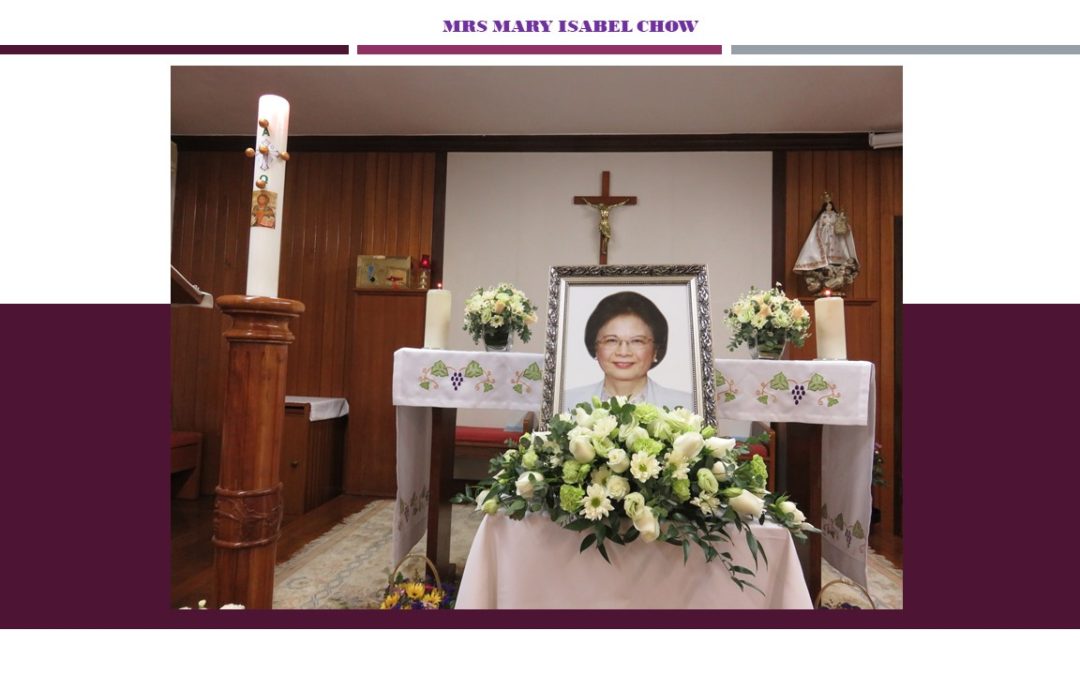
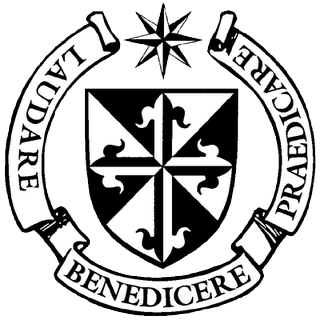
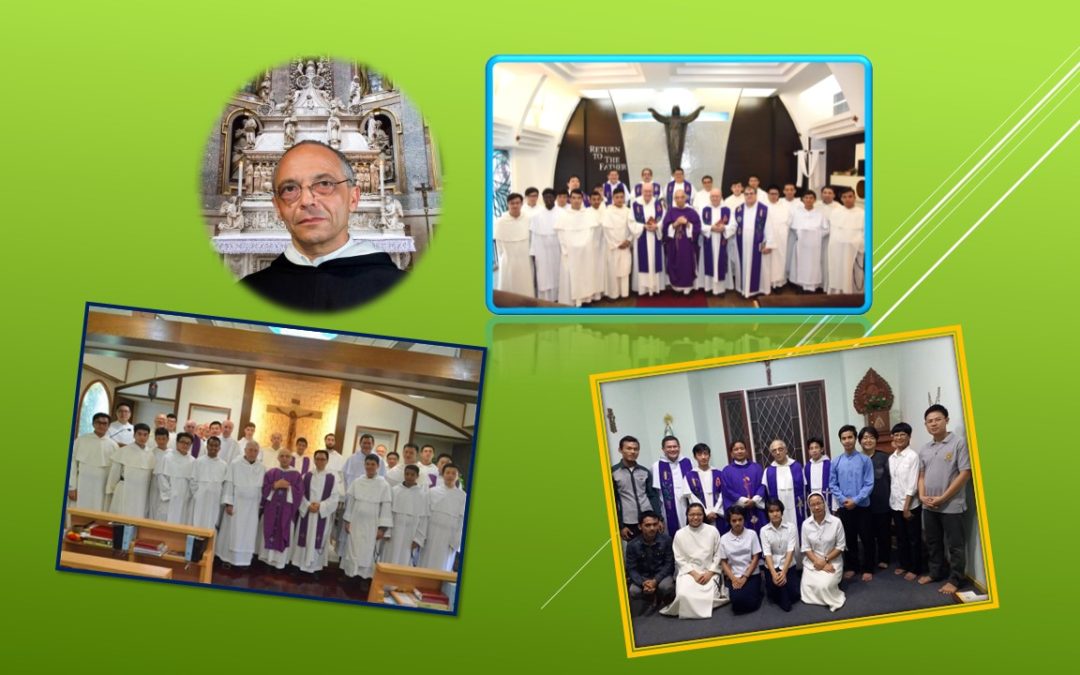
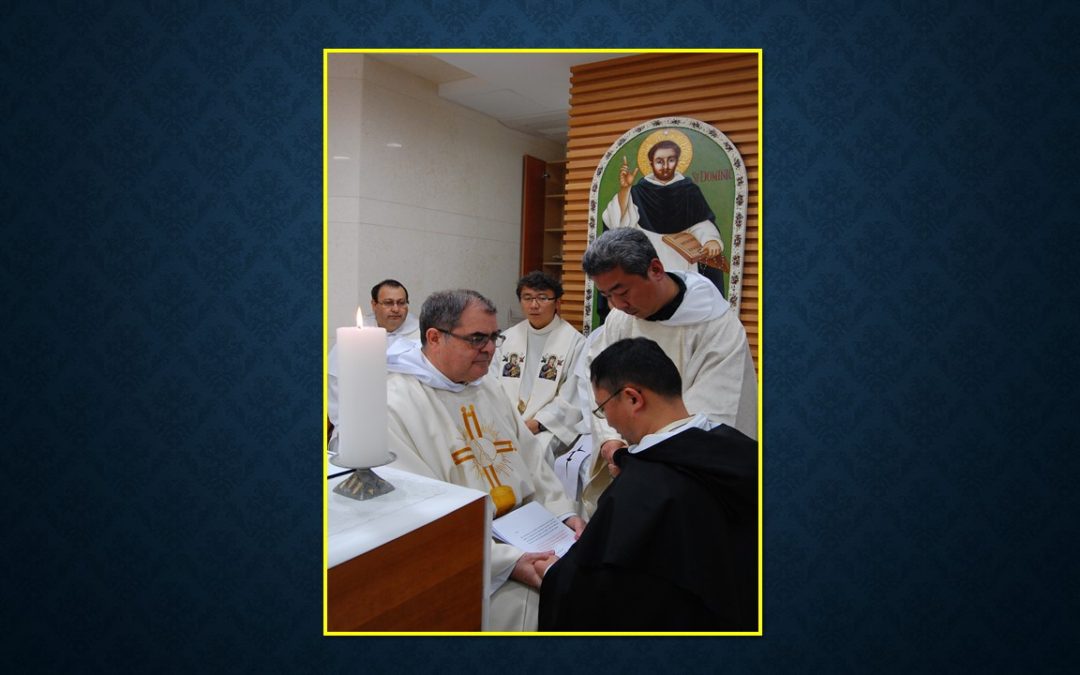
 Â Â
     Â
   

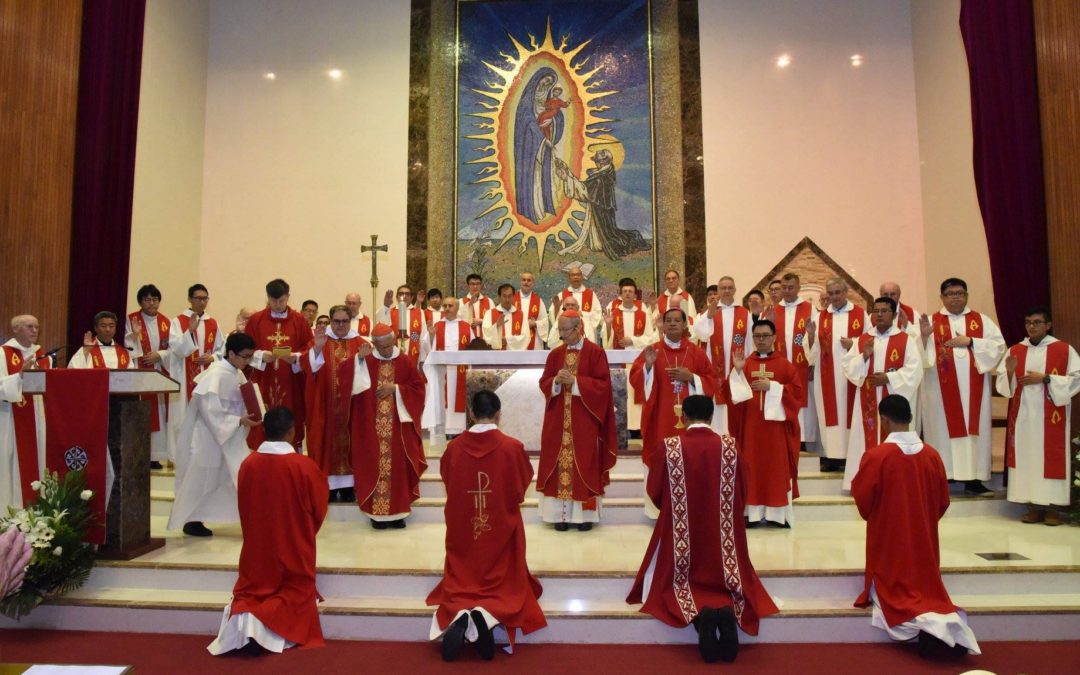
 Â
 
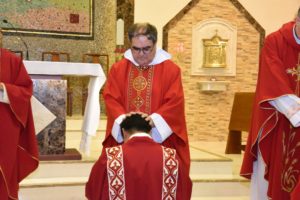
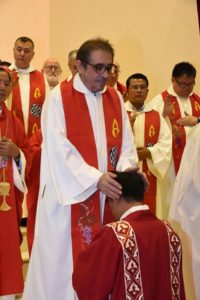 Â Â Â Â Â Â Â Â Â Â Â Â Â Â Â Â Â Â Â Â Â Â
                      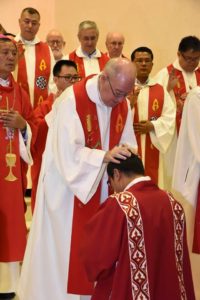
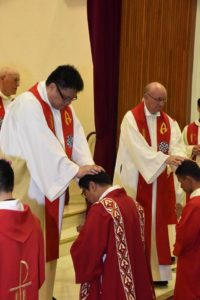 Â Â Â Â Â Â Â Â Â Â Â Â Â Â Â Â Â Â Â Â Â Â Â
                       